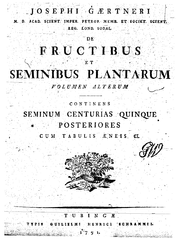
De Fructibus et Seminibus Plantarum
Encyclopedia

Joseph Gaertner
Joseph Gaertner was a German botanist, best known for his work on seeds, De Fructibus et Seminibus Plantarum ....
. The first volume was published in December 1788. The second volume was published in four parts, in 1790, 1791, 1791 and 1792 respectively. A third volume was published after Gaertner's death by his son Carl Friedrich von Gaertner from 1805 to 1807; this final volume is also known as 'Supplementum Carpologicae', abbreviated as Suppl. Carp..
De Fructibus was based on specimens of over a thousand genera
Genus
In biology, a genus is a low-level taxonomic rank used in the biological classification of living and fossil organisms, which is an example of definition by genus and differentia...
, including Australia
Australia
Australia , officially the Commonwealth of Australia, is a country in the Southern Hemisphere comprising the mainland of the Australian continent, the island of Tasmania, and numerous smaller islands in the Indian and Pacific Oceans. It is the world's sixth-largest country by total area...
n and Pacific specimens from the collection of Sir Joseph Banks
Joseph Banks
Sir Joseph Banks, 1st Baronet, GCB, PRS was an English naturalist, botanist and patron of the natural sciences. He took part in Captain James Cook's first great voyage . Banks is credited with the introduction to the Western world of eucalyptus, acacia, mimosa and the genus named after him,...
, and South Africa
South Africa
The Republic of South Africa is a country in southern Africa. Located at the southern tip of Africa, it is divided into nine provinces, with of coastline on the Atlantic and Indian oceans...
n specimens from the collection of Carl Peter Thunberg
Carl Peter Thunberg
Carl Peter Thunberg aka Carl Pehr Thunberg aka Carl Per Thunberg was a Swedish naturalist and an apostle of Carl Linnaeus. He has been called "the father of South African botany" and the "Japanese Linnaeus"....
. It was essentially a study of fruits and seeds, but the resultant classification was outstanding for its time.
Julius Sachs claimed that the work "forms an epoch in the history of botany", writing

